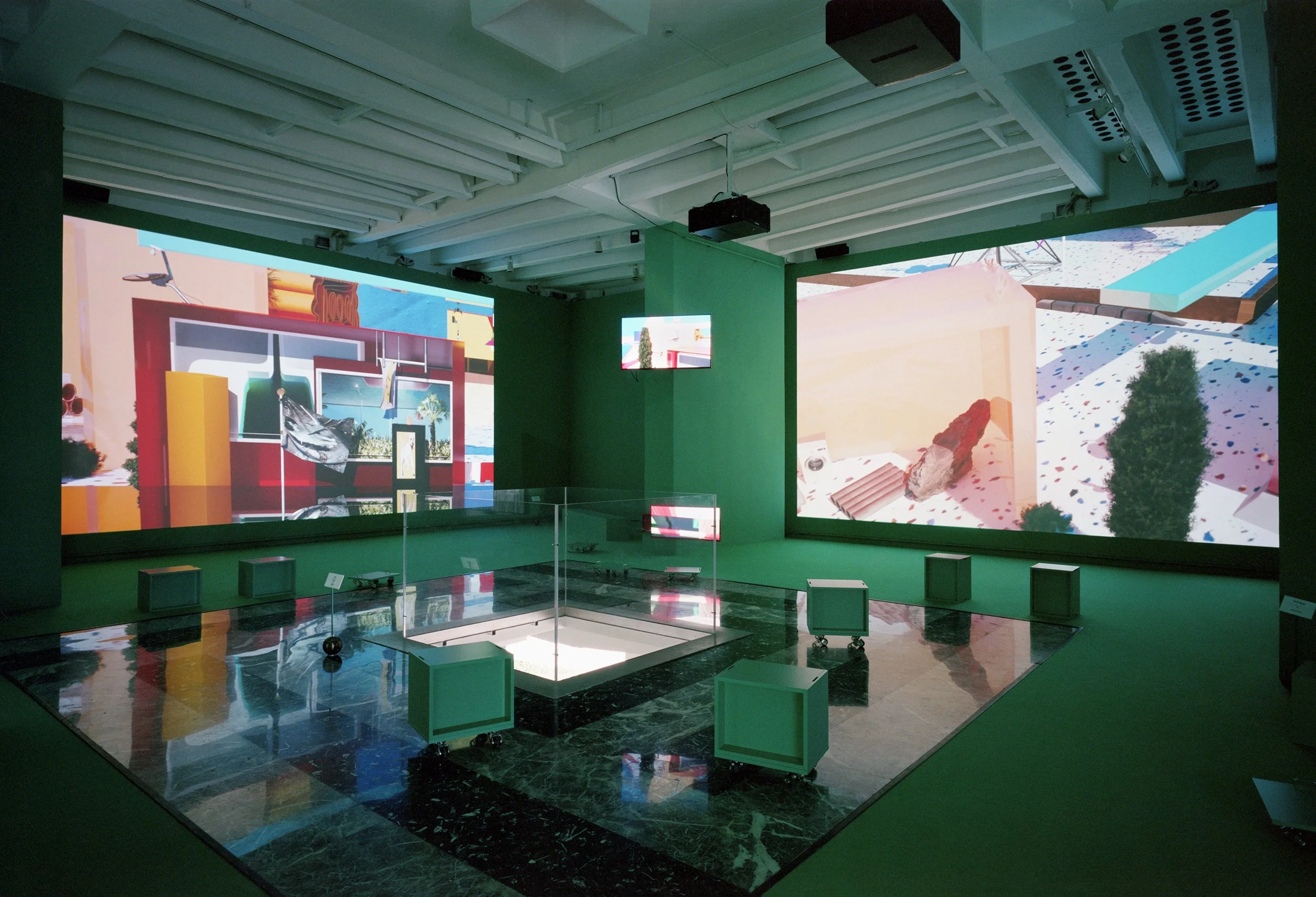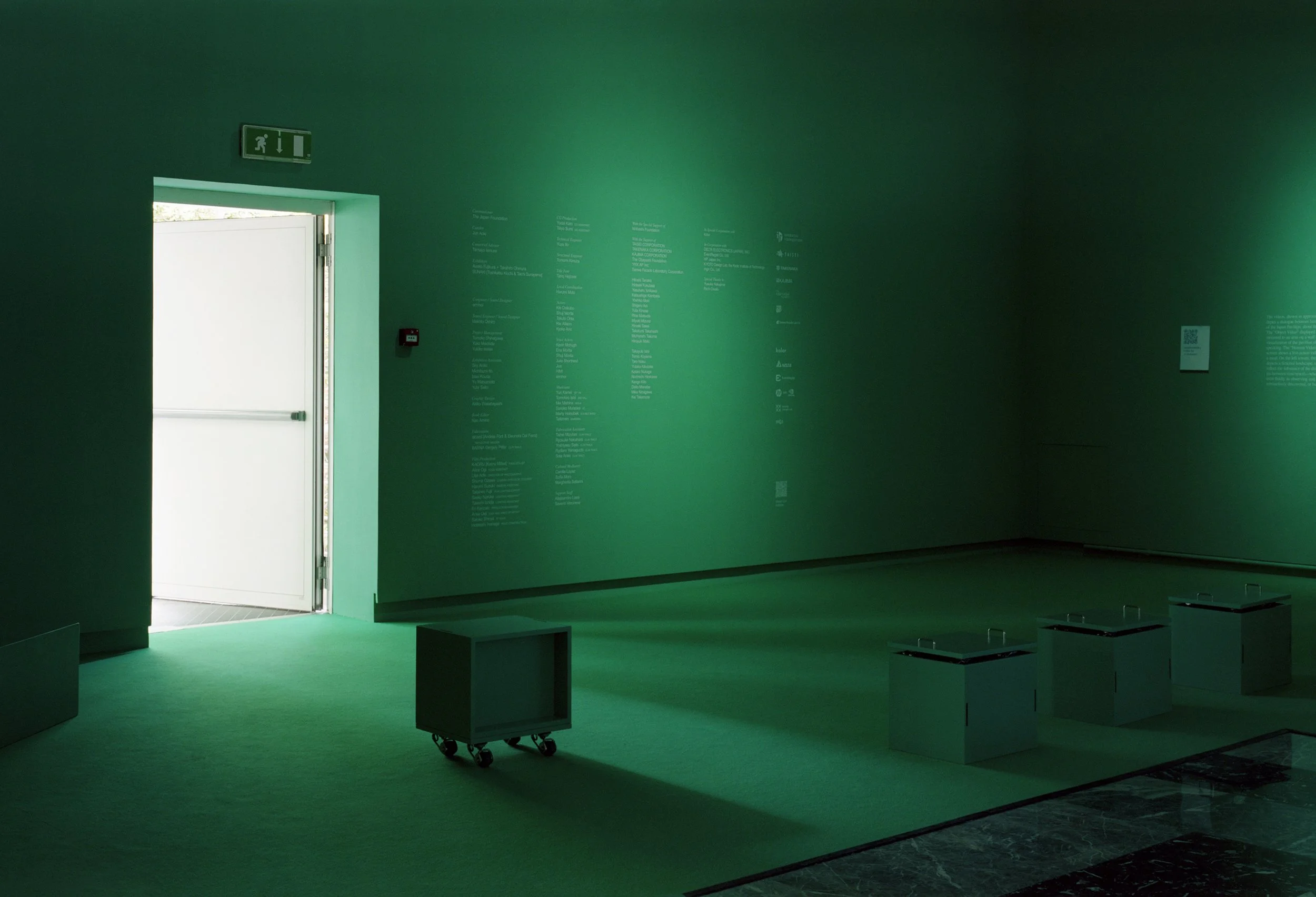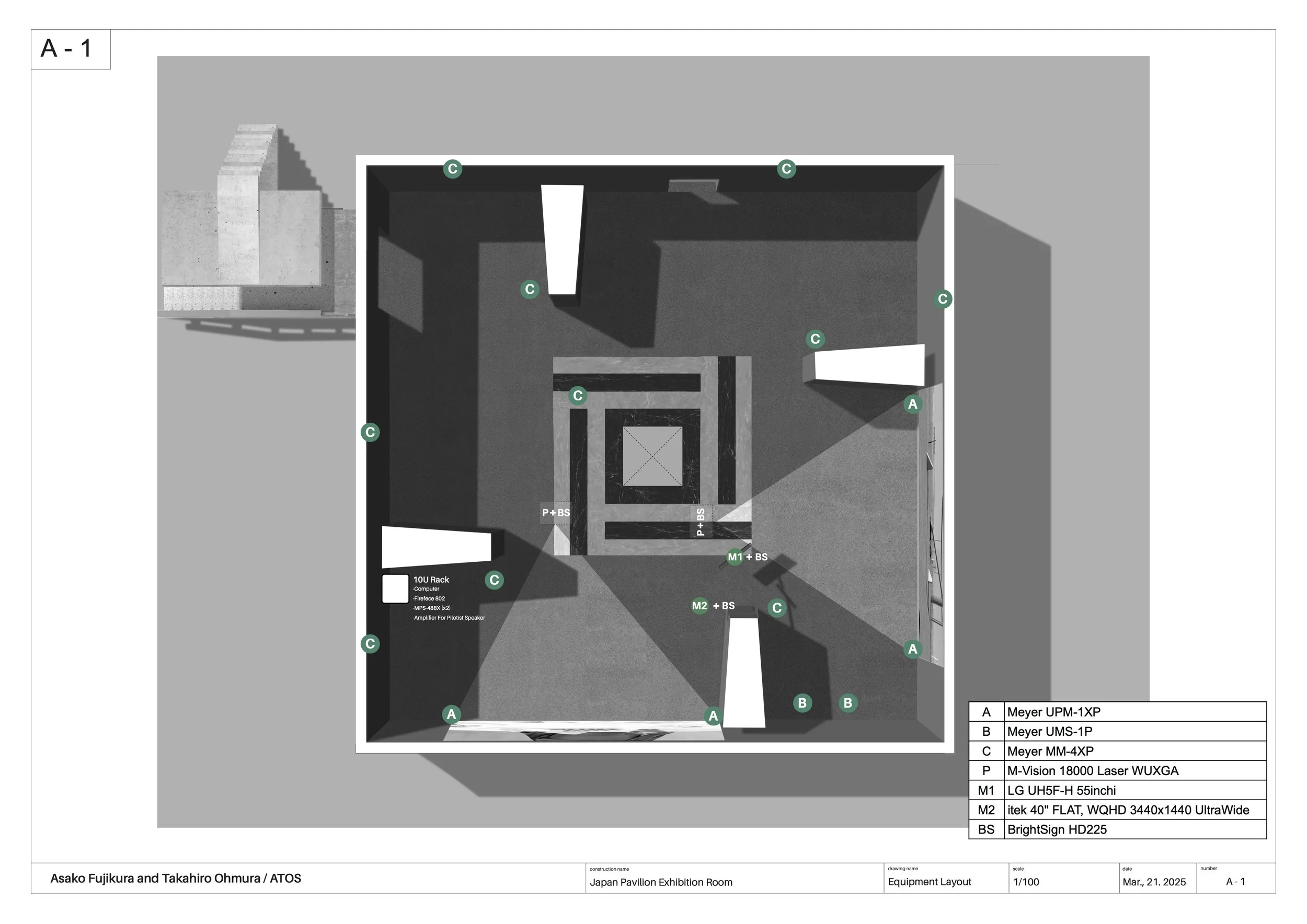Exhibition Design for IN-BETWEEN
Exhibition design, 2025
-
The exhibition design for the second-floor gallery of the Japan Pavilion at the 19th International Architecture Exhibition – La Biennale di Venezia situates visitors within IN-BETWEEN not as passive receivers of video works, but as embodied presences drawn into a field where moving image, sound, language, body, and architecture constantly interact.
The placement and scale of the two main screens, Construction Video and Human Video, were determined by lines connecting the gallery’s wall pillars, establishing the largest possible size that allows both to be viewed simultaneously without obstruction. In this arrangement, the pillars function not as obstacles but as devices for shifting modes of viewing: focusing on one screen naturally pushes the other to the periphery of vision, prompting visitors—echoing the Pavilion’s generative principle—to rotate their heads and move through the space, continually changing their focus.
The layout of sound was equally crucial. Sixteen speakers project each actor’s voice from its own “direction of presence”: near the Human Video screen, visitors hear human voices, clinking dishes, and chewing; near the Construction Video screen, fictional effects—explosions, construction noise—tied to the dialogue, all enveloped by an original score by ermhoi.
Though the Pavilion is highly reverberant, sound artist/engineer Makoto Oshiro’s acoustic design ensured each sound remained distinct, allowing the ear, like the gaze, to shift orientation and focus with clarity.
Original stools supported both movement and pause, maintaining visitors’ bodily awareness. Comprising a box unit and a wheel unit, they could be freely combined to glide across the space. Special spring casters in the legs added slight cushioning and sway, fostering a sense of “I am here” and triggering a feedback loop between fiction (videos and sounds) and reality (the Pavilion itself).
第19回ヴェネチア・ビエンナーレ国際建築展 日本館展示《IN-BETWEEN》にて藤倉麻子と大村高広が担当した2階展示室の会場構成。鑑賞者を単なる映像の受け手とせず、映像・音・言葉・身体・建築が互いに干渉し合う中立点の「なか」に巻き込むことを目的とした。
主たる要素である《Construction Video》と《Human Video》のスクリーンのサイズと位置は、壁柱同士を結んだラインを基準にしている。これは、壁柱に視界を阻まれることなく、ふたつのスクリーンを同時に視野に収めるという条件においての、スクリーンの最大サイズである。これにより壁柱は鑑賞の障害物ではなく、鑑賞のモードを切り替える装置として機能する。鑑賞者はどちらかの映像に集中すれば、もう一方は自然と視野の外に追いやられ、(日本館の生成原理と共鳴するように)首を回転させ、展示室を移動しながら、鑑賞の焦点を切り替えていくことになる。
こうした視線の回転運動と連動するかたちで、音のレイアウトも重要な設計要素となっている。展示室には16台のスピーカーが分散配置されている。各アクターの発話は、そのアクターの「存在する方向」から届くよう調整されている。さらにHVのスクリーン脇からは人間の声や食器音、咀嚼音が、CV側からは爆発音や工事音など言葉に即したフィクショナルな効果音が流れ、ermhoi氏による音楽が空間全体を包み込む。
日本館は「銭湯のよう」とも評されるほど反響の強い空間だが、サウンドアーティスト/サウンドエンジニアの大城真氏の音響設計により、個々の音が潰れず明瞭に分離して聞こえる(いわば「粒立って聞こえる」)空間環境が実現された。この音環境が、視線と同様、耳の方向性と集中の焦点を自律的に切り替えられる状況の立ち上げを可能にしている。
展示室を動き回り、ときに立ち止まることをサポートしつつ、同時に観るもの自身の身体をつねに意識下にとどめておくための装置として、専用のスツールも設計・制作された。このスツールはボックスユニットとホイールユニットに分かれ、鑑賞者はそれを自由に組み合わせながら、展示室内を滑るように移動し、任意の位置で映像を視聴することができる。また、脚部に取り付けられたキャスター(金具部そのものがバネになった特殊なスプリング・キャスター)は、座った際にわずかなクッション性と揺らぎを生み出す。この微細な揺れが「私はここにいる」という実感をもたらし、虚構(映像)と現実(日本館)のフィードバック・ループを立ち上げる起点となる。
-
Name Exhibition Design for IN-BETWEEN
Date 10 MAY – 23 NOV. 2025
Type Exhibition design
Venue Design Takahiro Ohmura
Sound Design Makoto Oshiro
Technical Engineer Yuya Ito
Exhibition Assistant Yudai Kato | Taiyo Sumi
Graphic Design Akiko Wakabayashi
Structural Engineer Tomomi Kimura
Title Font Tariq Heijboer
Local Coordination Harumi Muto
Commissioner The Japan Foundation
With the Special Support of
Ishibashi FoundationWith the Support of
TAISEI CORPORATION | TAKENAKA CORPORATION | KAJIMA CORPORATION | The Obayashi Foundation | YKK AP Inc. | Sanwa Facade Laboratory Corporation
Hitoshi Tanaka | Hideaki Fukutake | Yasuharu Ishikawa | Katsushige Kambara | Yoshiko Mori | Shigeru Aoi | Yuta Kinose | Rina Matsuda | Miyuki Mizuno | Hiroaki Sakai | Takafumi Takahashi | Michiyoshi Takuma | Hiroyuki Maki | Takayuki Ishii | Tomio Koyama | Taro Nasu | Yutaka Kikutake | Kotaro Nukaga | Norimichi Hirakawa | Kengo Kito | Daito Manabe | Mika Ninagawa | Kei TakemuraIn Special Cooperation with
kolorIn Cooperation with
DELTA ELECTRONICS (JAPAN), INC. | EventRegist Co., Ltd. | HP Japan Inc. | KYOTO Design Lab, the Kyoto Institute of Technology | mgn Co., Ltd









